Last Friday a handful of SitePointers and I attended an interesting new conference called ‘Above All Human – 2016‘ – now in its second year.
‘AAH’ is a conference that focuses on the intersection between humans and tech and so covers varied topics from medi-tech to astrophysics to game design theory. Anil Dash, Mike Monteiro and Katie Mack were among the speakers.
But I’d have to say my favorite talk was delivered by Ali Rayl. Ali is the Director of Customer Experience at Slack and she told a fascinating Slack origin story.
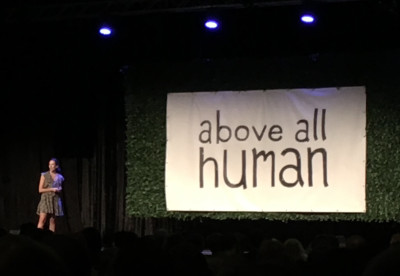
If you’re unfamiliar with Slack, it’s a workplace communication app, combining IM, email and Dropbox into a unified collaboration tool.
Although Slack doesn’t really do anything ground-breakingly new, somehow their mix of functionality and UX has really struck a chord with user and the app has taken off like wildfire over the last three years.
In fact, users all over the world have taken to organizing ‘Slack Channels’ around their own topics – from CSS to Star Wars to cognitive science. There’s a distinctively ‘Reddit-like’ self-organizing community feel to it. When users want to use your work tool in their spare time, you know you’ve got something.
Over the years many companies have tried to build ‘business communication tools’. Big companies like Microsoft, Lotus, and SalesForce with pockets that go down to their shoes too.
But none of them had managed to get wide-scale buy-in.
What Made Slack Different?
While lots of people know about Slack, fewer people know that the company behind it – then called Tiny Speck – was actually a failed game company. Ali was part of the team that built and released a game called ‘Glitch‘ back in 2009.
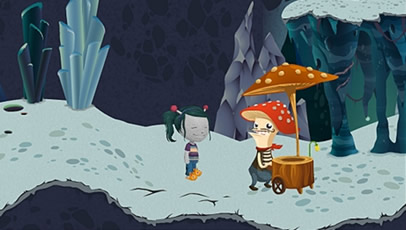
Glitch was a browser-based massively multiplayer online game. It provided a 2D cartoonish, open-world where players could:
- interact with each other
- collect/mine resources
- use those resources to create homes and other goods
- personalize and develop their avatar
There was no specific ‘end-goal’ or destination – it was designed to be a game-space that users could play in endlessly. It had recognizable elements from both Minecraft and Farmville.
Unfortunately, it didn’t quite work. Though Glitch was relatively successful in engaging an audience, they picked the wrong development platform – Adobe Flash. As more users spent their time on iPhone and Android, interest in flash-based gaming plummeted. Glitch closed in 2012.
But that wasn’t the end for Tiny Speck.
When they decided to build a communication tool, they began at a very different starting position to a traditional business software company like Microsoft. Working on Glitch, they’d learned how to take boring, time-consuming game tasks – like breaking rocks – and make them into a fun activity.
As keeping people in the game was central to their success, they put incredible amounts of work into making every interaction interesting, fun and irreverent. The actual ‘work’ performed by the Glitch user had no inherent value – but the process had to be entertaining enough kept them engaged.
The question was: Could you take that approach with real business work?
Slack was the experiment to find out. From the start, they avoided all the standard hallmarks of business software. The name was a little bit edgy and the logo and color scheme were bright, cheerful and a little bit goofy.
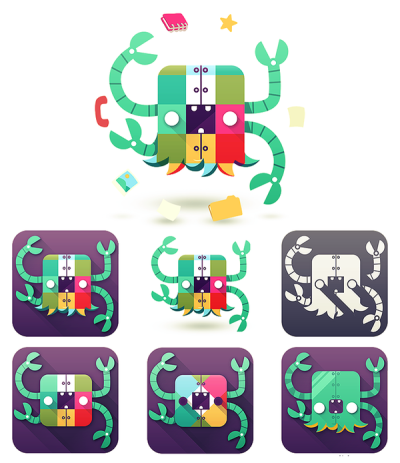
There was a cheeky ‘Slackbot’ to welcome you and endless folders of cheery emoticons. Effortless searching and posting of GIFs turned everyone into a comedian.
Soon people were customizing, hacking and bending Slack to their will.
First and foremost, this was a cool place for people to hang and chat and laugh. And since they were already there, people started getting actual work done too. Swapping files, discussing ideas, setting agendas. Why not, right?
Suddenly you had people doing business stuff in a business app – almost by stealth.
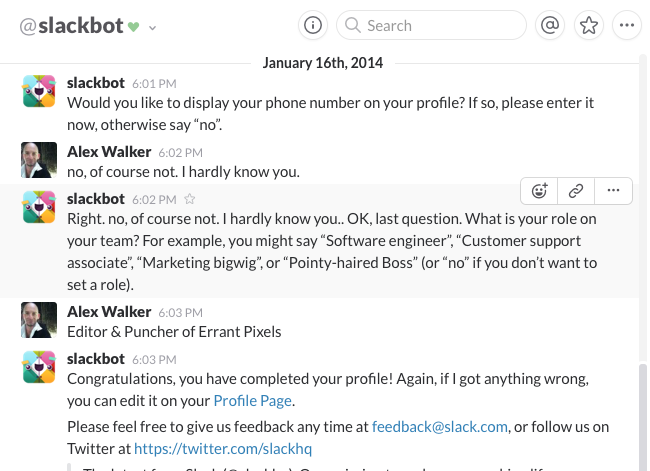
It’s interesting to compare this approach to safer, more conventional business app designs.
Most business applications are ‘document-centric’. When Microsoft created MS Word, they were building a ‘home for Word documents’ to live. Of course, people use Word, but the documents are really the ‘stars’ of Word. Likewise, Excel is a home for spreadsheets and Outlook is a home for emails.
So, it’s not too surprising that Microsoft Sharepoint would be primarily designed as ‘a home for files and conversations‘. Taking this approach, people are almost treated as ‘attachments to conversations‘.
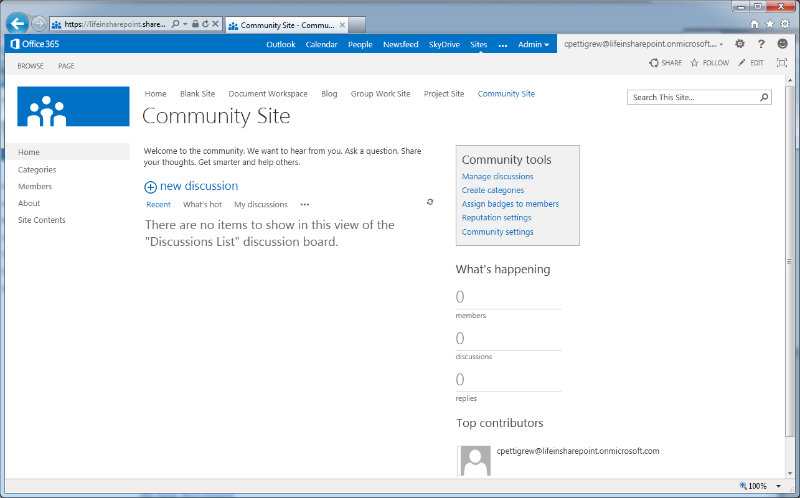
Like a tidy suburban train station, people might pass through SharePoint, but they would never dream of socializing there. People pass through and get out. And that is fatal to the art of conversation.
I’m unfairly using Microsoft as the comparison here, but none of their competitors did any better. SharePoint is a perfectly competent piece of software but I can’t remember anyone talk of their love for it.
On the other hand, I hear people declaring their love of Slack all the time. In software design, that’s an achievement. It’s nice to know that the DNA of Glitch inspires that love.
The Glitch is Back
Funnily enough, a dedicated group of Glitch users has been campaigning for its return for years. Last year the Slack team open-sourced the 10,000+ artwork files behind Glitch and a grassroots team of volunteers is working to return Glitch to the internet.
Clearly, love: It’s a Glitch (I had to get one more pun in).
Originally published in the SitePoint Design Newsletter.
Frequently Asked Questions (FAQs) about Slack and Glitch
What is the connection between Slack and Glitch?
Slack, the popular team collaboration tool, was born out of a failed gaming project called Glitch. The team behind Glitch, Tiny Speck, had to shut down the game due to lack of commercial success. However, they had developed an internal communication tool during the development of Glitch, which they realized could be a standalone product. This tool was refined and launched as Slack.
What was Glitch and why did it fail?
Glitch was a web-based massively multiplayer game developed by Tiny Speck. It was unique in its non-violent, cooperative gameplay and whimsical, imaginative world. However, despite its innovative concept and dedicated fanbase, Glitch struggled to attract a large enough audience to sustain its high development costs, leading to its closure.
How did Slack evolve from Glitch?
When Glitch was shut down, the team at Tiny Speck found themselves with a powerful tool they had developed for internal communication during the game’s development. They realized this tool had potential as a standalone product for team collaboration and communication. They refined and repurposed this tool, and Slack was born.
What were the key features of Glitch that influenced Slack’s development?
Glitch had a strong emphasis on collaboration and community, which influenced Slack’s focus on team collaboration. The game’s real-time chat system, which allowed players to communicate and collaborate, was a direct precursor to Slack’s real-time messaging system.
How did the failure of Glitch impact the development of Slack?
The failure of Glitch was a pivotal moment for the team at Tiny Speck. It forced them to reassess their product and focus on what worked – their internal communication tool. This tool was refined and launched as Slack, which has since become a leading tool for team collaboration.
What lessons did the team at Tiny Speck learn from Glitch’s failure?
The team at Tiny Speck learned valuable lessons about product-market fit and user needs from Glitch’s failure. They realized that while Glitch was loved by its users, it didn’t meet a broad enough need or attract a large enough audience to be commercially viable. These lessons informed the development of Slack, which was designed to meet a clear market need for better team communication tools.
How has Slack’s origin story influenced its company culture?
Slack’s origin story has shaped its company culture in significant ways. The experience of failure and reinvention has fostered a culture of resilience, innovation, and user focus at Slack. The company values learning from mistakes and is committed to continuous improvement and user satisfaction.
What is the legacy of Glitch in today’s gaming industry?
While Glitch was not a commercial success, it left a lasting legacy in the gaming industry. Its innovative, cooperative gameplay and unique, imaginative world have influenced a number of indie games. Moreover, its emphasis on community and collaboration has had a lasting impact on the design of multiplayer games.
How does Slack compare to other team collaboration tools?
Slack stands out from other team collaboration tools due to its user-friendly interface, powerful features, and seamless integrations with other tools. It offers real-time messaging, file sharing, and team collaboration features, making it a comprehensive solution for team communication.
What is the future of Slack?
Slack continues to evolve and innovate to meet the changing needs of teams and businesses. It is constantly adding new features and integrations to enhance team collaboration and productivity. With its strong focus on user needs and continuous improvement, Slack is well-positioned for continued growth and success in the future.
 Alex Walker
Alex WalkerAlex has been doing cruel and unusual things to CSS since 2001. He is the lead front-end design and dev for SitePoint and one-time SitePoint's Design and UX editor with over 150+ newsletter written. Co-author of The Principles of Beautiful Web Design. Now Alex is involved in the planning, development, production, and marketing of a huge range of printed and online products and references. He has designed over 60+ of SitePoint's book covers.



